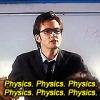
To be honest, I did not expect to be doing this sort of a thing when I chose to take AP Physics C, but I'm not complaining either.
A little about me first then. I believe I am fairly strong intellectually, particularly with math and science because I find it much more interesting than most other subjects. I hoping that AP Physics C will help me improve my calculus skills though, as the concepts are new to me. Having taken previous physics courses (what used be known as AP Physics C I took great interest in optics. I'm hoping to study Imaging Science in college, which is essentially the study of an imaging captured and perceived.
So now why AP Physics C? Well, having interned at the Rochester Institute of Technology's College of Imaging Science, I learned that physics and calculus are quite important for an Imaging Science major. For that purpose, I choose to take AP Physics C, hoping to improve my knowledge of physics and prepare myself for college. I'm really looking forward to the lab experience and I'm actually excited that we have such a small class size because we have all already started helping and working with one another on classwork and labs. I'm still a little anxious about having to teach myself individually without the help a lot of guided class lectures but I also think it will be a great lesson to learn as I move towards college.
I'd like to explain real quick what my blog is all about. Each of my posts is going to be based on an episode of Doctor Who. Haven't watched it? Here's a quick synopsis: its TV show about an time-travelling alien and his human companions and it recently had its 50th anniversary special. There's a lot of physics concepts that are ignored or worked around on the show so that's what I'm going to talk about. Each post will center around an episode, either a new one or a past one.
And let's hope I can come up some more interesting post titles...sorry about that. Oh and all the images used here are from Doctor Who.
Now...
- Read more...
- 1 comment
- 1,061 views

